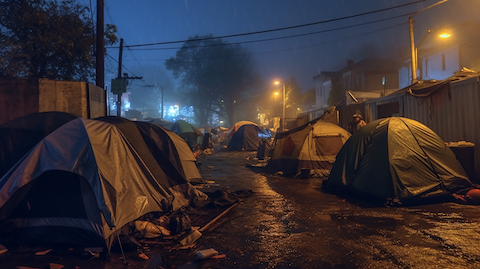
all the images in this post are Midjourney AI’s take on homelessness; none of these is drawn from, or depicts, any real person or actual place, and none of them are my own prompts
Rhyd Wildermuth wrote recently that he sees homelessness, substance addiction, massive-scale incarceration, and mental illness as all being harbingers of “late-stage” social and civilizational collapse. He worked with the victims of these crises for many years, so he knows what he’s talking about.
This predicament reflects the complete failure of our health system to properly address the needs of the ill — those incapable of caring properly for themselves, especially when traditional community/family support systems have vanished in our anonymous, atomized modern societies. That system has never been competent to deal with them — the use of forced institutionalization, lobotomization, and shock treatment has simply been replaced by abandonment, a giving up on even trying to address these people’s needs.
The problem is that the numbers of such people are skyrocketing. A staggering proportion of our young people are no longer in the labour pool because they are simply psychologically incapable of holding down a job. Growing numbers of people suffering from trauma are, in many cases, barely holding on. Aggravating this situation, the extreme inequality of wealth and power has pushed an ever-increasing proportion of the population “under water”, with debts exceeding their assets, and made them either homeless or very close to being so. Paying for health care is simply out of the question.
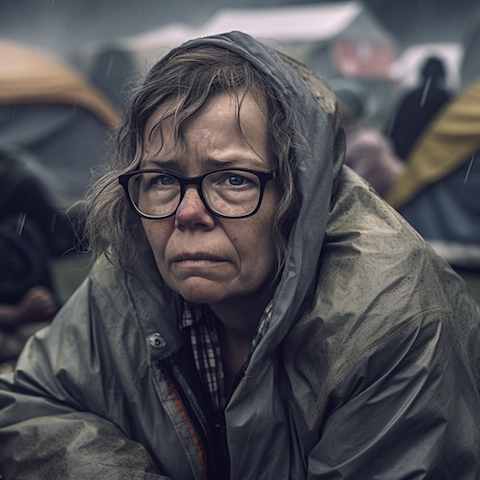
This is not the “fault” of the health system. Its workers are doing their best, but they are simply overwhelmed, and their “science” is just incapable of addressing the multiplicity of ailments and problems that have incapacitated a growing proportion of our population. The institutions that the ill are sometimes forcefully “committed” to cannot heal them. Arresting them over and over and sending them to prison (a large majority of “inmates” are sufferers of long-term trauma, substance addiction, and/or mental illness) certainly doesn’t help. And abandoning them to the streets, even in those very rare places that don’t harass them, don’t criminalize their behaviour, and offer a reasonably safe supply of drugs that help them numb their pain, is just as bad.
We have run out of alternatives, however, and nothing that we’ve tried has worked. So we’ve given up. As the numbers of our citizens who’ve been rendered socially and economically dysfunctional skyrocket, and as economic collapse worsens, this crisis, Rhyd warns us, is going to get much worse.
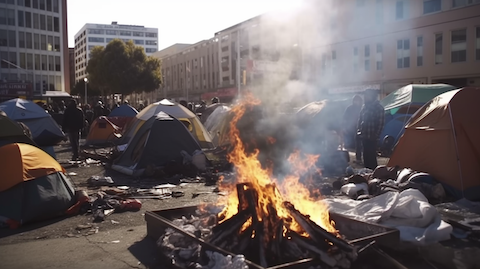
A few days ago, I drove (carefully) through Hastings Street and the adjacent streets in Vancouver’s Downtown Eastside, on my way to catch a ferry. This was the city’s biggest “tent city” area, that the city’s new right-wing government recently razed in a massive sweep and dislocation of Vancouver’s most vulnerable citizens. Many of the tents have reappeared, and the scenes are not unlike those depicted in this post. Everywhere you see mentally ill street people yelling and screaming, at no one in particular. Everywhere you see people staggering into the street almost getting hit by cars and buses. Everywhere you see people peeing and puking on curb-sides. Everywhere you see people banging their heads against walls, racked by tremors, slumping onto the ground, and sleeping (or otherwise unconscious), uncovered on the sidewalks.
I notice that Google Maps now steers drivers and pedestrians around this area. Whether that’s for people’s safety, or to prevent them having to witness this shameful scene of human misery and mistreatment, I do not know.

A recent NYT article profiled the situation in San Diego. It makes for gruesome and depressing reading, describing life for those on the street as a “daily game of Russian Roulette”.
Yet in Canada, governments at both ends of the political spectrum are back to studying forced institutionalization as the answer, even though this has never been shown to work, and often leads to even greater suffering. I suppose they at least want the problem out of public sight, where they, and we, can pretend it isn’t happening.
And that seems to be what all of the hand-wringing and street sweeps and calls for more police are really about. The top caste doesn’t care — it’s not their gated community homes and chauffeur-guarded limos being broken into by people desperate for their next meal, or their next fix.
The western cult of individuality would have us believe that this accelerating epidemic of illness and its many interwoven predicaments, are somehow the fault of the sick individuals themselves. We are not even close to ready to acknowledge that what I have called Civilization Disease has made us all — all eight billion of our bewildered ape species — mentally ill to one degree or another. We are just not meant to live this way. Those of us who are least capable of coping with this disease are the ones visible on our streets and in the drug poisoning statistics and coroners’ reports — the ones showing us what it might be like for us next as collapse deepens. The ones we don’t want to know, see or hear about.
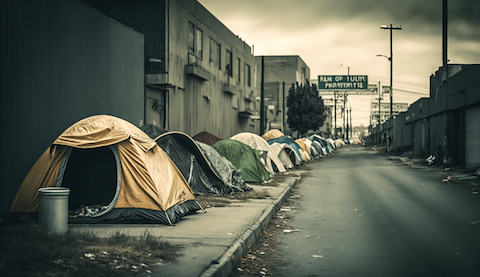
So what is our collective responsibility to our fellow sufferers? When most of us are struggling ourselves, what do we owe to those who just can’t cope with collapse, and are now living dysfunctional, deprived and dangerously precarious lives?
If every “institutional” solution to chronic mental illness and systemic grinding poverty has utterly failed, when and how do we, those of us not suffering as badly from Civilization Disease, step in to do what we can?
There is, of course, no answer to these questions. That’s why we shrug off responsibility for the predicament to health professionals, social workers, police and prison owners, when the predicament only worsens under their ‘stewardship’. And, worse, we often blame the victims themselves.
When almost everyone is living in a world of increasing stress and precarity, it seems that we tend to devolve to an “every person for themselves” mentality — while the members of the top caste take the proceeds of their oligopolies, inheritances, and tax cuts, abandon ship and head for their fenced bunkers in Hawai’i and New Zealand to wait out the storm.
So that’s apparently the default for our declining human civilization — those who cannot cope, and who don’t have personal support groups to carry them, will simply be abandoned, left in greater and greater numbers to die from poisoned drugs, street violence, malnutrition, exposure, or suicide, as collapse deepens.
I’m sure this is not what we want our civilization’s epitaph to be, even if there is no one left to read it — that we left our most vulnerable and helpless fellow humans to die because we were too busy looking after our own survival needs.
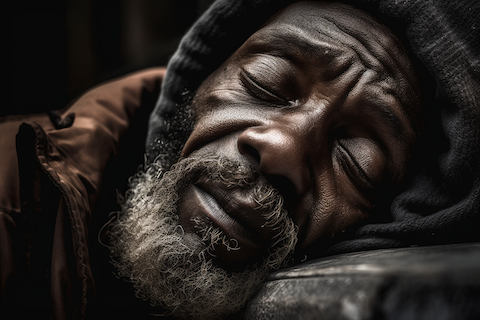
But this is where it looks like we are headed. Again, this is no one’s fault. We are all doing our best. We are conditioned, biologically and culturally, to look out for, and care for each other in times of abundance (just like these little guys), and, in times of extreme stress, scarcity and precarity, to hoard for ourselves, or to withdraw and die, to leave enough for the tribe’s survivors (also just like any other mammal). This is how nature restores balance when gentler methods fail. (Most creatures, deeply connected to their local ecosystems, instinctively regulate their own birth rates to prevent overpopulation and resource exhaustion; rarely do they face the predicament Civilization Disease has led our disconnected species to.)
Dmitry Orlov, in his books on collapse, tells us that while economic, ecological, and political collapse may be inevitable, and such collapses are hugely challenging, collapse can be manageable provided the situation doesn’t further deteriorate to the point of social collapse.
But it’s hard to see, from here, how we are going to be able to prevent such social collapse once our economic system collapses and takes down our political systems with it, especially when ecological collapse is guaranteed to make our situation much worse.
Still, there is something in me that instinctively believes we are going to rise to the occasion as things start to fall apart. We will only survive at all if and when we rediscover how to create and sustain real community. We have forgotten how to do this, but it’s been relearned before, as many stories of hardship, kindness and empathy during past depressions and wars attest. And I’ve seen with my own eyes communities that still work, where everyone looks after everyone else.
It may be a long way down, and a ghastly struggle for a while, with more suffering and death than we might have hoped. But my sense is that the survivors (a lot fewer than eight billion) will rediscover and rebuild communities, and they will re-engender the essential skills, the compassion, and the connection we will need to provide a foundation for post-collapse societies.
Hopefully, they will be societies immune to the ravages of Civilization Disease.





I suspect that, despite the recent visibility of the population of the unhoused, there were similar or greater numbers throughout the history of the Holocene and that after collapse there will still be people on the margins of society regardless of the nature of that society. At least we don’t have overt slavery now in most places, something that was very common in the past.
But given the magnitude of the dieoff that must happen, we are still living in the golden age of abundance. Imagine what Vancouver will be like when the population is starving to death faster than the bodies can be removed from the city or incinerated. Try putting that prompt in Midjourney. Then again, it probably wouldn’t look any worse than Bruegel’s painting The Triumph of Death, ca. 1562, which was at least partly influenced by the atrocities of the Inquisition.
Just read aloud to Connie, and we both loved it. Bravo, my friend!
It is amazing how well you see individuals who are injured. And how easily it would be possible that number to grow and engulf the next layer up and the next layer up without actually seeing that that process continues until he remaining support system feeds and cares for the residual population.
Your view suggests to the reader he or she while traumatized by the collapse will not be snuffed out by it.
This may be your lack of a computational view of the remaining supports. The computational view which sees less than 5% of today’s 8 billion to be supported after 2100.
If this were true then more than 10 billion would die of starvation and conflict between now and 2100. Not many of your readers or their friends or their children or any of the wealthy will be among them.
I completely agree with your views of individuals who are hurting and will be hurt but your computational blindness brings me sadness. Your views are not up to the task of having humankind behave to prevent these computational views.
https://www.evernote.com/l/AAmZY0Hicy9KbLmuRpZRVAjtdR3UQC_bhEE
In our continued state of massive overshoot
there is no hope that there will be a soft landing (= somewhat viable organization) for a sizable chunk of the current population. In all likelihood it will be crash and die-off when the food support systems finally give way. Personally, I expect something worse.
When the scramble for the last resources starts in earnest, nuclear destruction looks like an inevitable endgame for this clever species. I certainly don’t want to be among the unfortunate survivors.